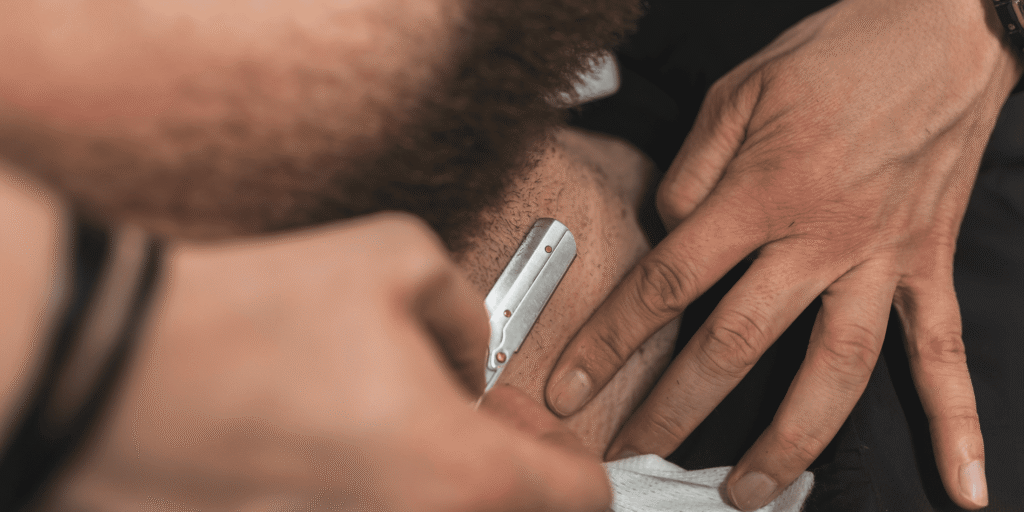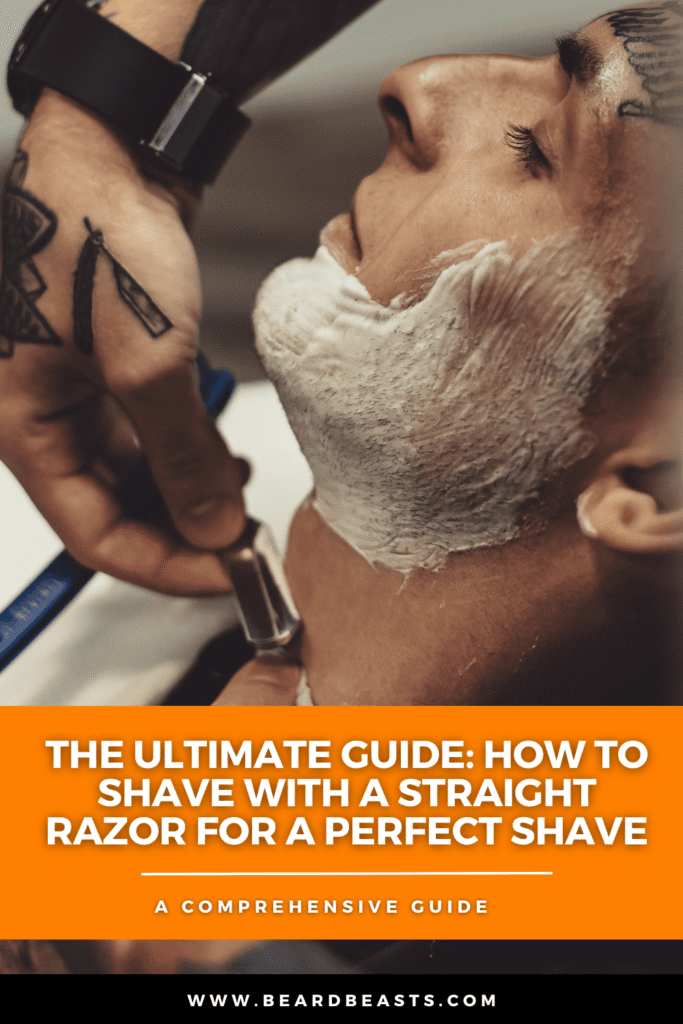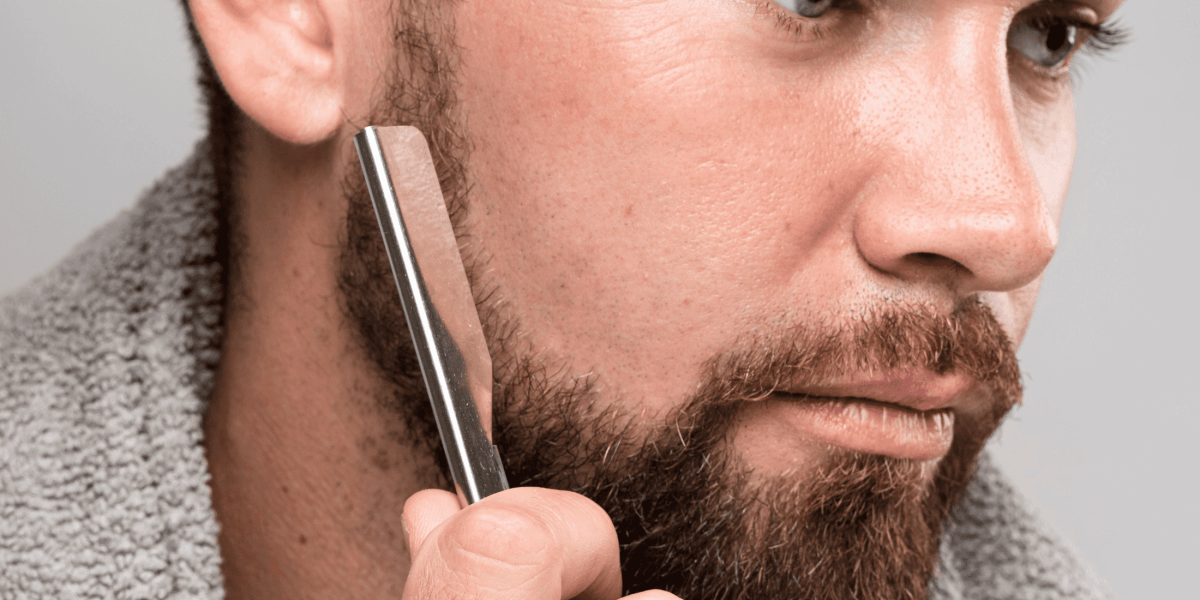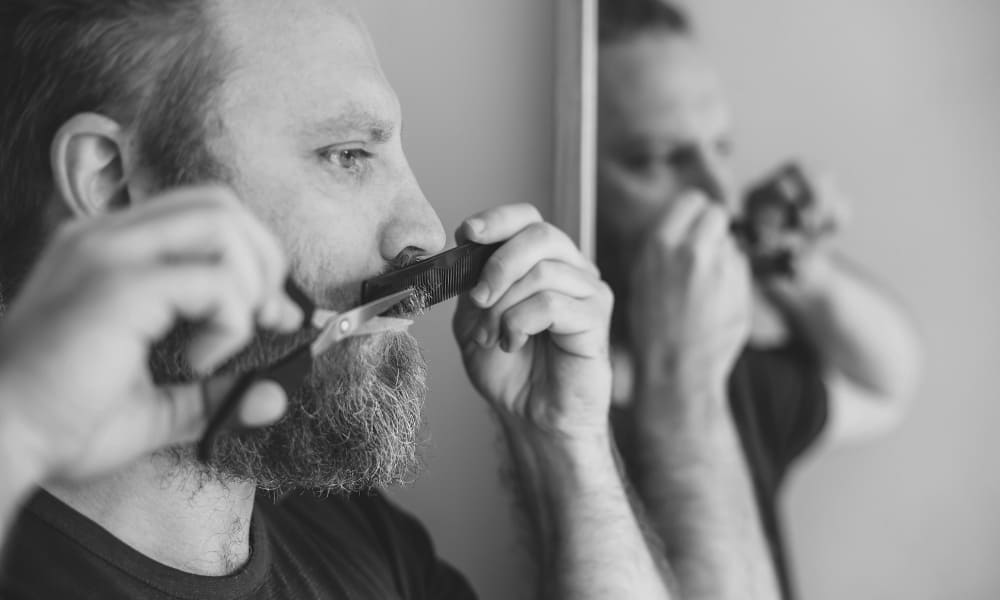Learning how to shave with a straight razor can transform your daily grooming routine into a sophisticated and satisfying ritual. This guide covers everything you need to know, from essential tools and preparation to mastering the perfect technique and maintaining your razor.
Enjoy benefits like a closer shave, cost-effectiveness, and eco-friendliness. Dive in and discover the timeless art of straight razor shaving!
What is a Straight Razor?
First things first, what is a straight razor? A straight razor, often known as an open razor or cut-throat razor, is a traditional shaving tool with a blade that folds into its handle. It dates back to the 17th century and has been a staple for achieving the closest, smoothest shave possible.

Straight razors were once the only option for men looking to shave until the invention of safety razors and electric shavers. Despite modern alternatives, many still prefer the precision and ritualistic experience of shaving with a straight razor.
Components of a Straight Razor
Understanding the parts of a straight razor is essential for mastering how to shave with a straight razor. Here are the key components:
- Blade: The sharp, cutting part of the razor, usually made from high-quality steel.
- Spine: The thicker, non-sharp edge of the blade that adds weight and stability.
- Edge: The sharpened side of the blade that does the actual shaving.
- Heel: The part of the blade closest to the handle.
- Point: The end of the blade opposite the heel; it can be rounded or pointed.
- Tang: The section of the blade that extends into the handle, helping with control.
- Scales: The handle, which protects the blade when folded and provides grip.
Types of Straight Razors
Fixed Blade vs. Replaceable Blade
There are two main types of straight razors:
Fixed Blade Straight Razor: This is the traditional type with a single, permanent blade. It requires regular honing and stropping to maintain its sharpness. Many enthusiasts prefer fixed blade razors for their longevity and classic appeal.
Replaceable Blade Straight Razor: Also known as a shavette, this type uses disposable blades. It offers convenience since you don’t need to hone or strop the blade. Simply replace the blade when it becomes dull. This type is often favored by beginners and barbers for its ease of use and hygiene.
Different Grind Types
Straight razors come in various grind types, affecting the blade’s sharpness and flexibility:
- Full Hollow Grind: Known for its thin, sharp edge, perfect for a close shave but requires skill to use.
- Half Hollow Grind: Offers a balance between sharpness and durability, making it a popular choice for both beginners and experienced shavers.
- Quarter Hollow and Wedge Grind: Thicker blades, ideal for heavy beards and those looking for a more forgiving shave.
Choosing the Right Straight Razor
Factors to Consider
Selecting the right straight razor is crucial for a great shaving experience. Here are some factors to keep in mind:
- Blade Size: Measured in inches, common sizes range from 5/8″ to 7/8″. Beginners might prefer a 5/8″ blade for better control.
- Material: High-carbon steel holds a sharper edge, while stainless steel is easier to maintain.
- Handle Type: Handles can be made from various materials like wood, plastic, or bone. Choose one that feels comfortable and balanced in your hand.
Recommendations for Beginners
If you’re new to straight razor shaving, consider starting with a replaceable blade straight razor (shavette) to practice your technique without the maintenance. Once you’re comfortable, you can invest in a fixed blade straight razor.
Best Straight Razor for Beginners:
- Blade Size: 5/8″ is ideal for its maneuverability.
- Grind Type: Half hollow grind for a balance of sharpness and ease of use.
- Handle Material: Opt for a handle that provides a good grip and feels comfortable.
Learning how to shave with a straight razor can be a rewarding experience, providing an unmatched level of closeness and satisfaction. By understanding what is a straight razor and the types and components, you’ll be well on your way to mastering this traditional shaving method.
Essential Tools and Preparations
Before you begin your journey on how to shave with a straight razor, you’ll need to gather some essential tools to ensure a smooth and enjoyable experience.

Here’s what you need:
- Straight Razor: The star of the show.
- Strop: A leather strap used to align and polish the blade before each shave.
- Shaving Soap: Creates a rich lather to lubricate and protect your skin.
- Shaving Brush: Typically made from badger, boar, or synthetic bristles, it helps to whip up the shaving soap and apply it evenly.
- Shaving Bowl: A bowl to mix and hold your lather.
- Towel: A hot towel can soften your beard and open pores, making the shave easier.
Optional Tools:
- Pre-Shave Oil: Provides an extra layer of lubrication, reducing the risk of cuts and irritation.
- Alum Block: A natural antiseptic to soothe the skin and close pores post-shave.
Having the right straight razor tools in your shaving kit can make a world of difference in your shaving experience.
Preparing Your Face
The key to a great shave lies in the preparation. Proper pre-shave preparation ensures that your skin is ready and your beard is soft, making it easier to achieve a close and comfortable shave.
Steps for Pre-Shave Preparation:
- Cleaning: Wash your face with warm water and a gentle cleanser to remove dirt and oils.
- Exfoliating: Use a mild exfoliator to remove dead skin cells, which can help prevent ingrown beard hairs.
- Moisturizing: Apply a light moisturizer or pre-shave oil to hydrate the skin and soften the beard.
By following these shaving preparation tips, you can reduce the chances of irritation and achieve a smoother shave.
Preparing the Razor
Properly preparing your straight razor is crucial for a safe and effective shave. There are two main processes to keep your razor in top condition: honing and stropping.
Honing vs. Stropping:
- Honing: This process involves sharpening the blade using a whetstone. It’s typically done less frequently, perhaps a few times a year, depending on how often you shave.
- Stropping: This is a more regular maintenance step. Stropping aligns the edge of the blade, making it straight and sharp without removing much metal.
How to Strop a Straight Razor:
- Attach the Strop: Secure one end of the strop to a stable surface.
- Hold the Razor: Grip the razor by the tang with the spine leading.
- Stropping Motion: Move the blade back and forth along the strop, keeping the spine in contact with the leather. Use light pressure and ensure the entire blade touches the strop.
Properly stropping a straight razor before each shave ensures your blade is sharp and ready, significantly improving your shaving experience.
By understanding and utilizing these essential tools and preparation techniques, you’ll be well-equipped to master the art of shaving with a straight razor. This preparation not only enhances the quality of your shave but also ensures a more enjoyable and satisfying experience.
How to Shave with a Straight Razor
Ready to get started with your straight razor shave? This section will guide you through each step, from creating the perfect lather to mastering the right technique. Let’s dive in and make your shaving experience smooth and enjoyable!
Lathering Up
Creating a perfect lather is a crucial step in learning how to shave with a straight razor. It not only protects your skin but also ensures a smoother glide for the razor.
Choosing Between Shaving Cream and Soap
For this traditional shaving method, shaving soap is the preferred choice. Unlike creams, soaps create a richer, more lubricating lather that stays put during your shave. Plus, the process of working up a lather from soap can be a relaxing part of your shaving ritual.
How to Create the Perfect Lather
- Wet the Brush: Soak your shaving brush in warm water for a minute, then shake off excess water.
- Load the Brush: Swirl the damp brush on the shaving soap for about 30 seconds to load it with soap.
- Build the Lather: Transfer the loaded brush to your shaving bowl and whip in circular motions. Add drops of water as needed until you achieve a thick, creamy lather.
- Apply to Face: Using circular motions, apply the lather to your face, working it into your beard to lift the hairs and prepare your skin.
By mastering how to lather for shaving, you’ll set the foundation for an enjoyable and effective shave.
The Right Technique
Using the correct technique is vital for a successful straight razor shave. Here’s how to do it:
Holding the Straight Razor Correctly
- Grip: Hold the razor with your dominant hand, using your thumb and three fingers. The handle should rest between your pinky and ring finger.
- Angle: Maintain a 30-degree angle between the blade and your skin. This angle helps cut the hair without scraping the skin.
The Three-Pass Shave
To achieve the closest shave, follow the three-pass shave method:
- With the Grain: Shave in the direction of hair growth. This first pass reduces the bulk of the hair.
- Across the Grain: Shave perpendicular to the hair growth direction. This pass gets closer to the skin.
- Against the Grain: Shave against the direction of hair growth. This final pass achieves the smoothest result but is optional for sensitive skin.
Understanding the straight razor shaving technique and knowing how to hold a straight razor properly will significantly enhance your shaving experience.
How to Shave with a Straight Razor: Step-by-Step Guide
Here’s a detailed guide on how to shave with a straight razor:
Detailed Steps for a Smooth Shave
- Prep Your Face: Follow the pre-shave preparation steps (cleaning, exfoliating, moisturizing).
- Lather Up: Apply a rich lather of shaving soap to your face.
- Start Shaving:
- Begin with the sides of your face. Use short, confident strokes.
- Shave with the grain on the first pass, rinsing the blade frequently.
- Re-lather and shave across the grain for the second pass.
- Optionally, re-lather and shave against the grain for the final pass.
- Tighten Skin: Use your free hand to pull the skin taut. This provides a smoother surface for the razor.
- Rinse and Repeat: After each pass, rinse your face with warm water, re-lather, and proceed to the next pass.
Common Mistakes to Avoid
- Using Too Much Pressure: Let the weight of the razor do the work. Applying too much pressure can cause nicks and irritation.
- Incorrect Angle: Maintain the 30-degree angle. Too steep or too shallow can lead to cuts or ineffective shaving.
- Skipping Pre-Shave Preparation: Neglecting to prepare your skin can result in a rough shave and increased irritation.
By following this step-by-step straight razor shave guide and avoiding common mistakes, you’ll be on your way to mastering how to shave with a straight razor.
Aftercare
Proper aftercare is essential to ensure your skin stays healthy and your straight razor remains in top condition. Here, we’ll cover the steps for a soothing post-shave routine and the best practices for maintaining your razor, so you can continue to enjoy a smooth and comfortable shave every time.
Post-Shave Routine
A proper post-shave routine is essential to keep your skin healthy and irritation-free after learning how to shave with a straight razor. Here’s how to ensure your skin feels smooth and refreshed.
Rinsing and Cooling Down
- Rinse with Warm Water: After your final pass, rinse your face with warm water to remove any remaining lather and hair.
- Cool Down: Splash your face with cold water or apply a cold, damp towel to help close your pores and soothe the skin.
Applying Aftershave Balm or Lotion
Using the right aftershave products is crucial for soothing and hydrating your skin:
- Aftershave Balm: Look for an aftershave balm that is alcohol-free to prevent drying out your skin. Balms with ingredients like tea tree oil and avocado oil are great for calming irritation.
- Aftershave Lotion: If you prefer lotions, choose one with moisturizing properties to keep your skin hydrated.
By following this post-shave routine, you’ll help reduce any potential irritation and keep your skin feeling smooth and refreshed. Finding the best aftershave balm or lotion for your skin type can make a significant difference in your overall shaving experience.
Razor Maintenance
Maintaining your straight razor properly is just as important as the shave itself. Proper care will extend the life of your razor and ensure a consistently smooth shave.
Cleaning the Razor After Use
- Rinse Thoroughly: After shaving, rinse the blade under warm water to remove any lather, hair, and skin residue.
- Dry Completely: Use a soft towel to pat the blade dry. Make sure it’s completely dry to prevent rust and corrosion.
Storing the Razor Properly
- Keep it Dry: Store your razor in a dry place. Humidity can cause the blade to rust.
- Use a Razor Stand or Case: Invest in a stand or a protective case to keep the razor safe and the blade protected.
- Periodic Oil Application: Lightly coat the blade with mineral oil if you won’t be using it for an extended period. This provides an extra layer of protection against moisture.
By adhering to these straight razor maintenance tips, you’ll ensure your razor remains in excellent condition, ready for your next shave. Knowing how to clean a straight razor and the importance of storing a straight razor properly will help you get the most out of your shaving tool.
Maintaining a good post-shave routine and taking proper care of your razor are essential steps in mastering how to shave with a straight razor. These practices will not only enhance your shaving experience but also ensure your skin and razor are well taken care of, providing you with the best shave possible every time.
Troubleshooting and Tips
No matter how experienced you become with straight razor shaving, occasional issues like nicks, cuts, and skin irritation can arise. In this section, we’ll cover some practical tips and solutions to help you tackle these common problems and ensure your shaving routine remains smooth and enjoyable.
Dealing with Nicks and Cuts
Even with the best technique, nicks and cuts can happen when learning how to shave with a straight razor. Knowing how to handle them quickly and effectively will keep your skin in great shape.
First Aid for Shaving Cuts
- Rinse with Cold Water: Immediately rinse the cut with cold water to clean it and constrict the blood vessels.
- Apply Pressure: Use a clean towel or tissue to apply gentle pressure to the cut until the bleeding stops.
- Use an Alum Block or Styptic Pencil: These are great for stopping the bleeding and disinfecting the cut. Simply wet the alum block or styptic pencil and apply it to the cut for a few seconds.
- Antiseptic and Moisturize: After the bleeding stops, apply a mild antiseptic and then a moisturizer to aid healing.
Tips to Prevent Nicks and Cuts
- Proper Technique: Maintain the correct angle (30 degrees) and use light pressure.
- Sharp Blade: Ensure your razor is sharp and well-maintained to avoid tugging and cutting.
- Stretch the Skin: Use your free hand to keep the skin taut while shaving.
- Take Your Time: Shaving with a straight razor is an art. Rushing can lead to mistakes.
By following these shaving safety tips, you can minimize the chances of getting nicks and cuts and handle them effectively when they do occur.
Common Shaving Problems and Solutions
When you first learn how to shave with a straight razor, you might encounter a few common issues. Here’s how to solve them:
- Symptoms: Red, irritated skin that feels like it’s burning.
- Solutions:
- Proper Lubrication: Always use a rich lather from shaving soap.
- Right Technique: Use a light touch and avoid going over the same area multiple times.
- Post-Shave Care: Apply a soothing aftershave balm to calm the skin.
Ingrown Hairs
- Symptoms: Red bumps that can be painful and inflamed.
- Solutions:
- Exfoliation: Regularly exfoliate to remove dead skin cells that can trap hairs.
- Shave with the Grain: Shaving in the direction of hair growth reduces the risk of hairs growing back into the skin.
- Avoid Tight Clothing: Right after shaving, avoid wearing tight clothing around the shaved areas to prevent irritation.
Dry Skin
- Symptoms: Flaky, itchy skin after shaving.
- Solutions:
- Hydration: Drink plenty of water to keep your skin hydrated from the inside out.
- Moisturize: Use a good moisturizer after shaving to keep your skin soft and hydrated.
- Use Quality Products: Ensure your shaving soap is of high quality and includes moisturizing ingredients.
Preventive Measures:
- Consistent Routine: Stick to a regular shaving routine to keep your skin accustomed to the process.
- Proper Prep: Always follow the pre-shave preparation steps to ensure your skin is ready for a close shave.
- Skin-Friendly Products: Choose products that suit your skin type to avoid irritation.
Mastering how to shave with a straight razor involves not only perfecting your technique but also knowing how to deal with the occasional mishaps and common issues. With these troubleshooting tips and solutions, you’ll be well on your way to achieving the perfect shave every time.
Frequently Asked Questions
Navigating the world of straight razor shaving can raise a lot of questions. Here, we’ve compiled answers to some of the most common queries to help you master how to shave with a straight razor effectively and safely.
Is it Better to Shave with a Straight Razor?
Benefits of Using a Straight Razor:
- Closer Shave: A straight razor provides an incredibly close shave, often superior to modern razors.
- Cost-Effective: Although the initial investment might be higher, in the long run, straight razors are more cost-effective since you don’t need to replace the blades frequently.
- Eco-Friendly: Straight razors generate less waste compared to disposable razors and cartridge blades.
- Skill and Tradition: Shaving with a straight razor is a timeless skill that offers a satisfying and ritualistic experience.
Overall, whether it’s better depends on personal preference and your willingness to learn the technique of how to shave with a straight razor.
Do You Need Shaving Cream to Use a Straight Razor?
While traditional shaving creams are popular, shaving soap is highly recommended for straight razor shaving. Here’s why:
- Rich Lather: Shaving soap creates a thick, protective lather that enhances razor glide.
- Better Hydration: It keeps your skin hydrated, reducing the risk of irritation and cuts.
- Longer Lasting: A puck of shaving soap typically lasts longer than a can of shaving cream, making it more economical.
So, while you don’t need shaving cream, using shaving soap is a crucial part of the preparation process for a smooth shave.
How Do You Shave with a Straight Razor for Beginners?
Shaving with a straight razor for beginners can be intimidating, but here’s a simplified guide to help you get started:
- Prep Your Face: Cleanse, exfoliate, and moisturize your face.
- Create a Lather: Use a shaving brush and soap to build a rich lather.
- Apply the Lather: Apply it to your face in circular motions.
- Hold the Razor Properly: Use a 30-degree angle and hold the razor with your dominant hand.
- First Pass: Shave with the grain (the direction your hair grows).
- Rinse and Repeat: Re-lather and shave across the grain for the second pass.
- Optional Pass: For an even closer shave, re-lather and shave against the grain.
- Aftercare: Rinse with cold water and apply aftershave balm to soothe your skin.
For beginners, take your time and focus on mastering each step. The process of how to shave with a straight razor will become easier with practice.
Can You Shave “Down There” with a Straight Razor?
Shaving sensitive areas with a straight razor requires extra caution:
- Preparation: Ensure the area is clean and well-prepared with warm water and shaving soap.
- Technique: Use gentle strokes and be extremely careful with the blade angle.
- Skin Tightness: Keep the skin taut to avoid nicks and cuts.
- Aftercare: Apply a soothing balm or lotion post-shave to reduce irritation.
While it’s possible to shave sensitive areas with a straight razor, it’s not generally recommended for beginners due to the high risk of cuts and irritation. Practice and confidence with the razor on less sensitive areas are advisable before attempting this.
Mastering how to shave with a straight razor opens up a world of benefits, from closer shaves to a more sustainable grooming routine. Whether you’re a beginner or looking to expand your shaving horizons, understanding the essentials, proper techniques, and aftercare will make your shaving experience smooth and satisfying. Remember, practice makes perfect, and with time, you’ll enjoy the timeless art of straight razor shaving.

Conclusion
Shaving with a straight razor is more than just a grooming routine; it’s a rewarding ritual that combines skill, tradition, and a sense of personal accomplishment. By now, you should have a solid understanding of how to shave with a straight razor, from the essential tools and preparations to the shaving process itself and proper aftercare.
Key Takeaways:
- Understanding the Straight Razor: Know the types, components, and how to choose the right one for you.
- Essential Tools and Preparations: Gather the necessary tools like a strop, shaving soap, and brush, and prepare your face and razor properly.
- The Shaving Process: Master the techniques of lathering, holding the razor, and the three-pass shave for a smooth finish.
- Aftercare: Implement a post-shave routine and maintain your razor to keep both your skin and tool in top condition.
- Troubleshooting and Tips: Address common issues like nicks, razor burn, and ingrown hairs effectively.
Benefits of Shaving with a Straight Razor:
- Provides a closer shave
- Is more cost-effective in the long run
- Is eco-friendly with less waste
- Offers a satisfying and traditional experience
Remember, the journey of learning how to shave with a straight razor is unique to each individual. Patience and practice are your best allies. Enjoy the process, take your time, and soon enough, you’ll find yourself looking forward to this daily ritual.





